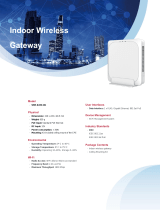
Aruba 510 Series Campus Access Points | Installation Guide 11
uniquement avec une antenne dont le type et le gain maximal doivent être approuvés par Industrie Canada.
Pour réduire les interférences radio potentielles, le type d’antenne et son gain doivent être choisis de façon à ce
que la puissance isotrope rayonnée équivalente (PIRE) ne dépasse pas les valeurs nécessaires à une
communication efficace.
Ce périphérique est conforme aux règlements RSS exempts de licence d’Industrie Canada. L’utilisation de ce
périphérique est soumise aux deux conditions suivantes : (1) ce périphérique ne doit pas provoquer
d’interférences, et (2) ce périphérique doit accepter toute interférence, y compris les interférences susceptibles
de provoquer un dysfonctionnement.
En cas d'utilisation dans la plage de fréquences de 5,15 à 5,25 GHz, cet appareil doit uniquement être utilisé en
intérieur afin de réduire les risques d'interférence avec les systèmes satellites mobiles partageant le même
canal.
Canadian Caution
This radio transmitter model APIN0514/APIN0515 has been approved by Industry Canada to operate with the
antenna typeslisted in the table in the online ordering guide (link provided below) with the maximum
permissible gain indicated. Antenna types not included in this list, having a gaingreater than the maximum gain
indicated for that type, are strictly prohibited for usewith this device.
http://www.arubanetworks.com/assets/og/OG_AP-510Series.pdf
Le présent transmetteur radio modèle APIN0514/APIN0515 a été approuvé par Industrie Canada pour
fonctionner avec les types d'antennesindiqués dans le tableau du guide de commande en ligne (lien fourni ci-
dessous) avec le gain permissible maximum indiqué. Il est strictement défendu d'utiliser avec cet appareil les
types d'antennes non inclus dans cette liste, ayant un gain supérieur au gain maximumindiqué pour ce type.
http://www.arubanetworks.com/assets/og/OG_AP-510Series.pdf
European Union Regulatory Conformance
The Declaration of Conformity made under Radio Equipment Directive 2014/53/EU is available for
viewing at: www.hpe.com/eu/certificates. Select the document that corresponds to your device’s model number
as it is indicated on the product label
This radio transmitter model has been approved to operate with the antenna types listed in the online ordering
guide (link provided below) with the maximum permissible gain indicated. Antenna types not included in this list,
having a greater gain than the maximum gain indicated for the type, are strictly prohibited for use with this
device. Compliance is only assured if the Aruba approved accessories as listed in the ordering guide are used.
http://www.arubanetworks.com/assets/og/OG_AP-510Series.pdf
Wireless Channel Restrictions
5150-5350MHz band is limited to indoor only in the following countries; Austria (AT), Belgium (BE), Bulgaria (BG),
Croatia (HR), Cyprus (CY), Czech Republic (CZ), Denmark (DK), Estonia (EE), Finland (FI), France (FR), Germany (DE),
Greece (GR), Hungary (HU), Iceland (IS), Ireland (IE), Italy (IT), Latvia (LV), Liechtenstein (LI), Lithuania (LT),
Luxembourg (LU), Malta (MT), Netherlands (NL), Norway (NO), Poland (PL), Portugal (PT), Romania (RO), Slovakia
(SK), Slovenia (SL), Spain (ES), Sweden (SE), Switzerland (CH), Turkey (TR), United Kingdom (UK)
.
Radio Frequency Range MHz Max EIRP
BLE/Zigbee 2402-2480 9 dBm
Wi-Fi
2412-2472 20 dBm
5150-5250 23 dBm
5250-5350 23 dBm
5470-5725 30 dBm
5725-5850 14 dBm
Lower power radio LAN product operating in 2.4 GHz and 5 GHz bands. Please refer to the ArubaOS User Guide/
Instant User Guide for details on restrictions.














